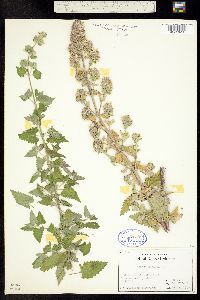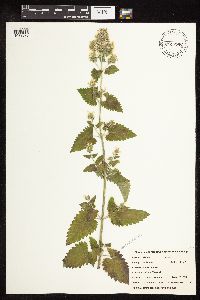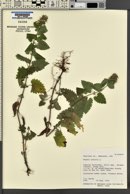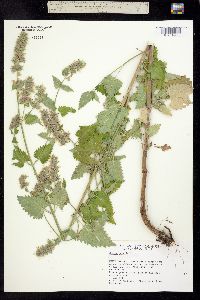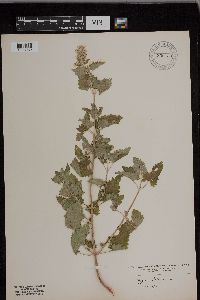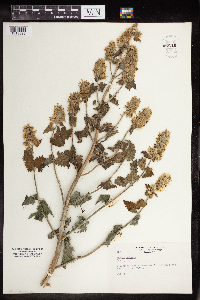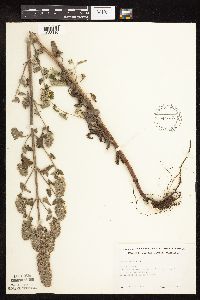Nepeta cataria
|
|
|
|
Family: Lamiaceae
Catnip, more...catmint, catwort, field balm
|
Plant: perennial herb; aromatic; sparsely pubescent; stems 3-15 dm tall Leaves: 1-3.5(-5) mm wide, 1.5-4.5(-7) mm long, deltoid, stipulate; petioles 1-4 cm long; base subcordate; margin crenate with veins terminating between marginal teeth INFLORESCENCE: verticils tightly clustered at branch tips forming a large leafy panicle Flowers: pedicels 0.5-2.5(-3.5) cm long; calyx urceolate, persistent, ca. 4 mm long, pubescent with short glandular hairs, the lobes acuminate, with magenta veins; corolla white to pink, the lower lip crenate, with magenta spots; stamens with white filaments, the anthers purple, declining towards lower corolla lip; pistil magenta Fruit: NUTLETS 2 mm long, 1 mm wide, longitudinally concave towards center, oval-concave in cross-section Misc: Oak and pine forest, stream banks, roadsides, waste places; 1200-2150 m (4000-7000 ft); May-Sep REFERENCES: Walters, Gretchen M. 2003. Lamiaceae. J. Ariz. - Nev. Acad. Sci. Volume 35(2). Christy et al. 2003 Duration: Perennial Nativity: Non-Native Lifeform: Forb/Herb General: Aromatic perennial with sparsely pubescent stems 30-150 cm tall. Leaves: Blades 1-3.5 mm wide, 1.5-4.5 mm long, deltoid and stipulate, on petioles 1-4 cm long, the base subcordate and the margins crenate with veins that terminate between the marginal teeth, blades sessile near the top of plant. Flowers: Verticillate cyme of tightly clustered verticils at branch tips that form a large leafy panicle, the flowers on pedicels 0.5-2.5 cm long, urceolate calyx, persistent, about 4 mm long, pubescent with short glandular hairs, the lobes acuminate, with magenta veins, the corolla white to pink, the lower lip crenate, with magenta spots, stamens with white filaments and purple anthers, magenta pistil. Fruits: Nutlets, oblong, glabrous mm long, 1 mm wide, longitudinally concave toward center. Ecology: Found in disturbed sites, roadsides, and along stream banks from 4,000-7,000 ft (1219-2234 m); flowers May-September. Notes: Distinctive with its crenate margined leaf blades, the deltoid shape is key along with the tightly clustered verticils of flowers. Ethnobotany: Used against intestinal worms, as a cold remedy, for coughs, for fevers, for boils and swellings, as a sedative to soothe infants, for headaches, against diarrhea, as a sleeping aid, blood purifier, for rheumatism, and the leaves were made into a tea. Etymology: Nepeta is the Latin name for catnip, while cataria means pertaining to cats. Synonyms: None Editor: SBuckley, 2010 Taprooted perennial; 3-10 dm, branched above, finely and densely canescent throughout; lvs all cauline, triangular-ovate, cordate or truncate at base, 3-8 cm, coarsely toothed, the petiole half as long as the blade; fl-clusters 2-6 cm, continuous or interrupted, rather loosely many-fld; cal at anthesis 5-7 mm, weakly bilabiate, the lobes half as long as the tube; cor 8-12 mm, dull white, dotted with pink or purple, the lower lip crenulate; 2n=32, 34, 36. Native of Eurasia, now established in disturbed habitats throughout our range and w. July-Oct. Gleason, Henry A. & Cronquist, Arthur J. 1991. Manual of vascular plants of northeastern United States and adjacent Canada. lxxv + 910 pp. ©The New York Botanical Garden. All rights reserved. Used by permission. From Flora of Indiana (1940) by Charles C. Deam Prefers a moist or dry sandy soil and is frequent to common in all parts of the state. Too frequent in waste places about dwellings, truck gardens, pastures, and open woodland. At our home we regard it as an obnoxious weed, and even by persistent efforts can not entirely eradicate it. …… Indiana Coefficient of Conservatism: C = null, non-native Wetland Indicator Status: FACU |
|
|
|










































